Black-footed Phoebastria nigripes and Laysan P. immutabilis Albatrosses breed in mixed colonies at a number of islands in the North Pacific. Occasionally odd-looking birds are seen that are deemed to be hybrids between the two species.
Pete Leary, Midway Atoll Wildlife Biologist, reports that currently there are at least four such hybrids on Midway Atoll's Sand Island, two of which are illustrated here. They are seen trying to display with either Laysans or Black-foots, depending on the bird, but the prospective mates lose interest very quickly and move away once an incorrect dance move is made. One of the hybrids, nicknamed ‘Herbie', lives near the island's Midway House and can be seen daily. Pete reports that Herbie, thought to be a male, has never had any luck with the Laysans and to his knowledge has not been seen engaging in preening activity with other birds.
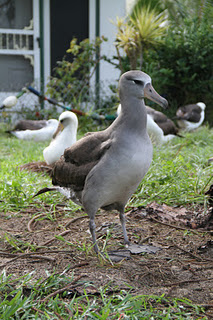
'Herbie', the hybrid Black-footed-Laysan Albatross on Midway, November 2011
Photograph by Pete Leary
In 2008 Lindsay Young, ACAP North Pacific News Correspondent, identified seven hybrids on Midway among c. 82 000 occupied nests during a survey.
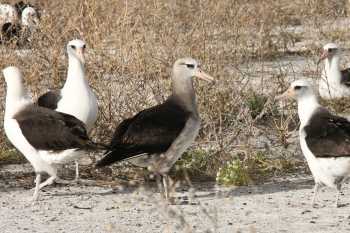
Another hybrid Black-footed-Laysan Albatross on Midway, November 2011
Photograph by Pete Leary
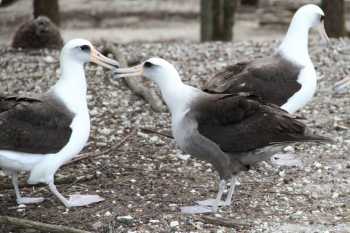
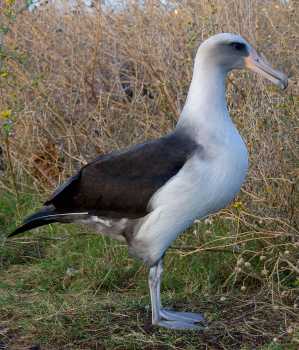
Hybrid Black-footed-Laysan Albatrosses on Midway, 2008
Photographs by Lindsay Young
Click here to view a 2008 photo of another presumed Black-foot-Laysan hybrid, named ‘Prius', thought to be a male by its size, from Tern Island, Northwestern Hawaiian Islands. "He tends to socialize mostly with black-footed albatross, but his dance repertoire contains moves from both species. His vocalizations also sound like a mixture between the two species".
A profusely-illustrated paper by Tristan McKee and Peter Pyle in North American Birds in 2002 goes into detail on hybridization between the two species. In summary, the authors consider that hybrids come about by inter-specific extra-pair copulatory events or rapes, and not by birds of the two species pairing up and laying a fertile egg, from which they rear a fledgling. It seems these events are always(?) caused by male Black-footed Albatrosses, with the hybrid chick being reared by its Laysan mother and her cuckolded male Laysan partner. This is said to explain why the hybrids appear, at least in the main, to be imprinted on Laysan Albatrosses, and not on Black-foots.
McKee and Pyle state that presumed hybrids have been seen incubating eggs (as illustrated here) and rearing chicks to fledging with Laysan Albatross females, leading to F2 (second generation) hybrids.
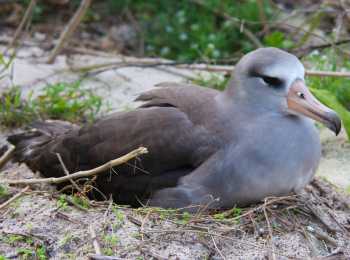
Hybrid Black-footed-Laysan Albatross incubating on Midway, 2008
Photograph by Lindsay Young
These fascinating observations would best be sorted out by a genetic study, and although it is reported that one has been undertaken, its results apparently remain unpublished.
A half-downy chick photographed on Tern Island in 2006 and described as a hybrid (click here) is actually an aberrant Black-footed Albatross with a white belly and legs, according to Pete Leary. This bird is named ‘Oreo' and has been returning to the island since 2008. Such plumage variations are well described in the North American Birds article.
According to Lance Tickell's 2000 book Albatrosses hybridization has also been reported between Black-browed Thalassarche melanophris and Campbell T. impavida Albatrosses (click here) and between Northern Royal Diomedea sanfordi and Southern Royal D. epomophora Albatrosses. Both these species pairs are considered to be closely related: they certainly look more alike (to the human eye at least) than do Black-footed and Laysan Albatrosses. Among other ACAP-listed species, mixed pairs incubating eggs have been reported for the two giant petrels Macronectes spp. from more than one locality, but I have not come across a case of a hybrid individual, as the eggs laid have been infertile.
Reference:
McKee, T. & Pyle, P. 2002. Plumage variation and hybridization in Black-footed and Laysan Albatrosses. North American Birds 56(2): 131-138.
With thanks to Pete Leary, Midway Atoll Wildlife Biologist and Lindsay Young, ACAP North Pacific News Correspondent for photos and information. You can follow Pete's interesting blog "Pete at Midway" at http://peteatmidway.blogspot.com/.
John Cooper, ACAP Information Officer, 11 December 2011

 English
English  Français
Français  Español
Español